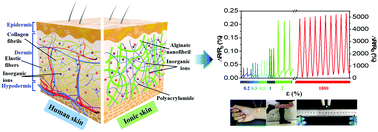Supramolecular nanofibrillar hydrogels as highly stretchable, elastic and sensitive ionic sensors†
Abstract
There is a growing demand for flexible and stretchable strain/pressure sensors for different applications. However, existing conductors usually cannot meet all the requirements for use in next-generation wearable sensors. In this work, we demonstrate a new class of nature-inspired ionic conductors based on supramolecular sodium alginate (SA) nanofibrillar double network (DN) hydrogels with complex shapes by injection. Owing to their dermis-mimicking structures, these hydrogels exhibit unique features, such as high transparency (99.6%), high tension/compression strength (0.750 MPa/4 MPa), high stretchability (3120%), high toughness (4.77 MJ m−3) and superior elasticity (100%) at high strain (1000%). In particular, the use of salts (e.g., NaCl) as triggers in supramolecular assembly combining SA makes the hydrogels ideal ionic conductors. The ionic conductors were demonstrated as strain sensors with high sensitivity to an extremely broad strain window (0.3–1800%) and a low applied voltage (down to 0.04 V), as well as with high pressure sensitivity (1.45 kPa−1). These hydrogel-based ionic sensors may find applications in sports monitoring, human/machine interfaces and soft robotics.

- This article is part of the themed collections: 2019 Materials Horizons Most Popular Articles and A selection of 2019 articles


 Please wait while we load your content...
Please wait while we load your content...